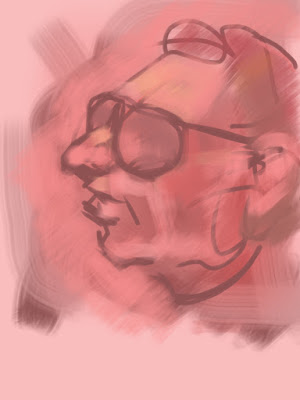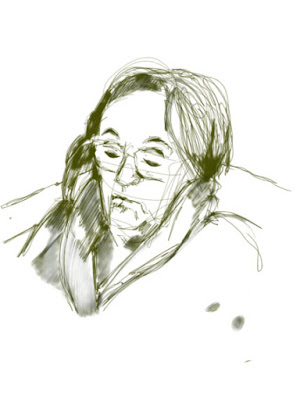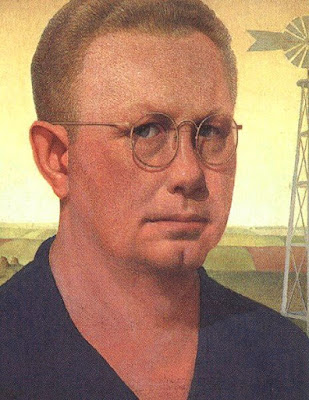A
post from a while back about missing a chance to see a painting by Caravaggio caught my eye a few days ago. During a trip to Kansas City I tried to visit the well-known St. John at the museum there, only to find that the painting was in Milan. The post reminded me about a visit to Rome some years ago that was more successful in finding works by Caravaggio. That particular trip found me with a free afternoon to seek out works by the Baroque master. Examples of Caravaggio's paintings are few in the United States, and I planned to see as many of his works there as I could. The ones I sought that day are available to see for essentially no cost.
Rome is wealthy with works by Caravaggio of course--no surprise, given that he spent the majority of his artistic career in the city. The museums of the city are replete with his work, but museums all charge admission fees. On previous visits to the city I had already seen the wonderful works in the
Galleria Borghese (The Sick Bacchus and David with the Head of Goliath are two favorites there) and
Galleria Pamphilij (a less-visited but fabulous family-owned palace-museum that owns the non-pariel Rest on the Flight into Egypt and the Penitent Magdalene). I have yet to visit the
Palazzo Barberini, which holds several, but certainly hope to do so one of these days. The works there by Caravaggio I'd most like to see include the famous Judith Beheading Holofernes.
 |
| Basilica of Sta Maria del Popolo (r) and Porta del Popolo (l), Rome. |
That afternoon was a solo jaunt through central Rome. Having no companions gave substantial freedom to linger and consider the works that interested me--five of them in two churches where they were installed when completed. You can actually see all five works for virtually no cost. The
Church of Santa Maria del Popolo is one of the two, and the other is
San Luigi dei Francesi. Each of these churches commissioned the artist to produce works for a side chapel, and the works remain in their original locations four hundred years afterward. For an American whose country is about half as old it's a staggering proposition.
The first destination was the
 |
| Church of San Luigi dei Francesi, Rome |
church called San Luigi dei Francesi (St. Louis of the French), partly because I didn't actually know how to find it and because it actually has three of the five works I was seeking. You don't usually find three in a museum, let alone a free-admission church. This particular church is located in what I sometimes think of as Caravaggio's neighborhood: the area surrounding the Piazza Navona, about a block away. The church was established for French people living in Rome, completed about 1589. A decade or so later, Caravaggio was commissioned to produce a cycle of paintings of St. Matthew. The works were to be installed in a chapel endowed in his will by Cardinal Contarelli (who despite his name was French). The original holder of the commission apparently could not complete the contract so Caravaggio was selected instead. Caravaggio was an up and coming artist in Rome who patron was an important cardinal who also lived in the area. Caravaggio produced his three Matthew paintings specifically for the space, carefully considering the space, wall sizes and lighting. Two on the side walls were the original commission. The altarpiece was added about two years later when sculptures weren't accepted for the space. These three paintings
 |
| "Calling of St. Matthew," ca 1599 |
have hung on these walls for more than 400 years. They show the calling of Matthew to discipleship, an angel providing inspiration for his gospel, and his eventual martyrdom. The Calling of St. Matthew is my particular favorite. We see Matthew the money-changer seated at a counting table, being skewered by a pointed finger from the shadows. The gesture is an obvious allusion to the finger of God extended to Adam on the Sistine ceiling, which Caravaggio would obviously have seen. Matthew is visibly surprised and seems to gesture, "Who, me?" The composition and grouping of figures in light and shadow is fascinating. You might expect that Jesus, the redeemer, would be placed in the light but instead he is obscured by another figure. A golden external light floods past his hand to light Matthew's forehead. It is easy to see why other artists admired Caravaggio's handling of light and shadow.
 |
| "Martyrdom of St. Matthew," ca 1599 |
On the right hand wall of the chapel is
The Martyrdom of St. Matthew, a darker and considerably more turbulent painting than the Inspiration. In this work we see the disciple being killed by a man in a loincloth, a soldier according to church lore, while saying mass. Caravaggio produced a work that fulfilled specifics of the commission and gave us a whirling violent scene. The lighted triangle of striking soldier and stricken saint stand out among a whirl of recoiling onlookers. Figures seem to flash in and out of view in the enveloping darkness, a likely symbol of oblivion. The artist himself might be the tiny face peering out at us from the deepest of the dark.
 |
| "Inspiration of St. Matthew, " 1602 |
The third painting in the chapel was done a couple of years after the first, when some statuary intended for the chapel was unsatisfactory.
The Inspiration of St. Matthew is the altarpiece in the chapel. It alludes to divine inspiration for the disciple writing his gospel. The brightly robed Matthew is being instructed by an angel hovering above. The two figures emerge in a sinuous dance of robes and figure against a darkly glowing background. The warm color of the saint's robes, the swirl of the angel's draperies and the motion evoked by them are transcendent. For me this one is probably the best-composed of the three, but I love them all.
Alas, today the chapel is so dark that one has to feed a light metering device to illuminate the three paintings for a minute or two at a time, so the wise visitor comes with a pocket full of Euros.
After using up my pocket change I regretfully left the San Luigi, just east of the Piazza Navona's north end, and headed to the Piazza del Popolo, a mile or so away. Most of central Rome is amenable to the pedestrian, so it was no trouble. I managed the walk in perhaps 20 minutes along the cobbled Roman streets. The Piazza del Popolo is a giant plaza at the northern end of the Via del Corso, the busy street running south to the Capitoline hill. At it's northern edge is the Porta del Popolo, once a city gate. The Piazza is quite large and heavily used most of the time by vehicles and people. Just to the east is the Pincian Hill and further east the big park-like Villa Borghese where the Galleria Borghese sits in its singular splendor.
The Basilica of Santa Maria del Popolo (pictured above, from across the Piazza) occupies a site just beside the Porta. The Basilica being adjacent to the Porta meant that for travelers, most of whom came from that direction, this was the first church they encountered in Rome, making this an important Christian place for at least a millennium, likely longer but
 |
| "Crucifixion of St. Peter," 1601 |
records earlier
than the 13th century have been lost. This church of the people dates from the 15th century although it has been remodeled several times. Caravaggio was becoming better-known when he painted these important works. These paintings depict the two most important saints of the church--Peter and Paul. Each shows a defining event in the life of the saint but more importantly they show us Caravaggio's genius with chiaroscuro and with composition.
In the
Crucifixion of St. Peter, he shows us the moment of the disciple's crucifixion. Peter is being raised into an inverted position, as the story of the saint says. Three men are working to raise the cross, one using his back beneath, another using a rope. Peter stares out of the picture, seemingly toward the altar of the chapel. Perhaps the oddest element of the picture, for me, is the enormous bum of the crouching man under the cross, intruding (and protruding) onto the viewer. Yet somehow it works. Caravaggio's use of light and dark and how he makes the skin tones glow are without peer. The other painting in the chapel, the
Conversion on the Way to Damascus, is fine as well, showing Saul on his back, having been
 |
| "The Conversion of St. Paul," 1601 |
stricken on the road to Damascus. That painting is actually the second for the space, the first having been rejected. In this painting the dark is deep and enveloping as well, and Saul (who became Paul) has almost fallen onto us, the viewers. In this particular work the composition is unusual--the dominant figure of the huge horse, looming over the fallen Paul.
Once I had visited these final two of my five Caravaggios, I rewarded myself with an espresso and a chocolate gelato in a sidewalk cafe across the plaza. It had been a fine afternoon, indeed.
---
Previously:
Missing Caravaggio






























